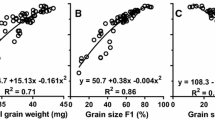Summary
Nitrogen exerts its influence on crop growth and grain yield in various ways. Early top dressings or a high level of soil nitrogen stimulate tiller formation and leaf growth, which results in an increase of shoot dry weight and leaf area index. Late top dressings promote the survival of ear-bearing tillers, grain set and leaf area duration.
Nitrogen compounds for grain growth are mainly supplied by the vegetative aerial parts (65–80%); the remainder originating from uptake and relocation by the roots after anthesis. The proportion of the total amount of nitrogen present in the grains, the nitrogen harvest-index, centers around 0.78 under optimum conditions.
The recommendations for nitrogen dressing are based on the amount of residual soil nitrogen and on the requirement of the crop in the given environment. Both components may vary considerably due to environmental constraints. Despite inaccuracies in the assessment of mineral nitrogen content of the soil and the predicted nitrogen requirement of the crop, the recommendations for splitting nitrogen dressing in winter wheat have considerably improved the efficient use of nitrogen fertilizer.
Similar content being viewed by others
References
Austin R B and Blacwell R D 1977. The nitrogen economy of winter wheat. J. Agric. Sci., Camb. 88, 159–167.
Austin R B, Bingham J, Blackwell R D, Evans L T, Ford M A, Morgan C L and Tailor M 1980 Genetic improvements in winter wheat yields since 1900 and associated physiological changes. J. Agric. Sci., Camb. 94, 675–689.
Benzian B and Lane P 1979 Some relationships between grain yield and grain protein of wheat experiments in South-East England and comparisons with such relationships elsewhere. J. Sci. Food Agric. 30, 59–70.
Darwinkel A 1980 Grain production of winter wheat in relation to nitrogen and diseases. Relationship between nitrogen dressing and yellow rust infection. Z. Acker Pflanzenbau 149, 299–308.
Darwinkel A 1980 Grain production of winter wheat in relation to nitrogen and diseases. Relationship between nitrogen dressing and mildew infection. Z. Acker Pflanzenbau 149, 309–317.
Dilz K, Darwinkel A, Boon R and Verstraeten L M J 1982 Intensive wheat production as related to nitrogen fertilization, crop protection and soil nitrogen. Proceedings no. 211 of The Fertilizer Society of London, pp 93–124.
Dubois J-B and Fossatie A 1981 Influence of nitrogen uptake and nitrogen uptake partitioning efficiency on grain yield and grain protein concentration of twelve winter wheat genotypes (Triticum aestivum L.). Z. Pflanzenzuecht. 86, 41–49.
Ellen J and Spiertz J H J 1980 Effect of rate and timing of nitrogen dressings on grain yield formation of winter wheat (T. aestivum L.). Fert. Res. 1, 177–190.
Evans L T 1980 The natural history of crop yield. Am. Sci. 68, 388–397.
Gregory P J, Marshall B and Biscoe P V 1981 Nutrient relations of winter wheat. 3. Nitrogen uptake, photosynthesis of flag leaves and translocation of nitrogen to grain. J. Agric. Sci., Camb. 96, 539–547.
Heyland K-U and Knopf, H E 1980 N-Angebot und N-Aufnahme und ihr zeitlicher Bezug zur Ertragsbildung von Winterweizen und Wintergerste. Bayer. Landw. Jahrbuch 57, 359–375.
Kramer Th 1979 Environmental and genetic variation for protein content in winter wheat (Triticum aestivum L.). Euphytica 28, 209–218.
Langer R H M 1980 The dynamics of wheat yield. N.Z. Wheat Review 1977–1979, 32–40.
Novoa R and Loomis R S 1981 Nitrogen and plant production. Plant and Soil 58, 177–204.
Pearman I, Thomas S M and Thorne G N 1978. Effect of nitrogen fertilizer on growth and yield of semi-dwarf and tall varieties of winter wheat. J. Agric. Sci., Camb. 91, 31–45.
Riggs T J, Hanson P R, Start N D, Miles D M, Morgan C L and Ford M A 1981 Comparison of spring barley varieties grown in England and Wales between 1880 and 1980. J. Agric. Sci., Camb. 97, 599–610.
Ris J, Smilde K W, and Wijnen G 1981 Nitrogen fertilizer recommendations for arable crops as based on soil analysis. Fert. Res. 2, 21–32.
Spiertz J H J and Van der Haar H 1976 Differences in grain growth, crop photosynthesis and distribution of assimilates between a semi-dwarf and a standard cultivar of winter wheat. Neth. J. Agric. Sci. 26, 233–249.
Spiertz J H J and Ellen J 1978 Effects of nitrogen on crop development and grain growth of winter wheat in relation to assimilation and utilization of assimilates and nutrients. Neth. J. Agric. Sci. 26, 210–231.
Spiertz J H J 1980 Grain production of wheat in relation to nitrogen, weather and diseases.In Opportunities for increasing Crop Yields. Eds. R G Hurd, P V Biscoe and C Dennis. pp 97–114. Pitman Publ. Lim., London.
Viaux Ph 1983 Nitrogen fertilization of winter wheat in France.In: The Nitrogen Requirement of Cereals. MAFF Reference Book 385, London, HMSO (In press).
Vos J 1981 Effects of temperature and nitrogen supply on post-floral growth of wheat; measurements and simulations. Agric. Res. Rep. 911, 164 p.
Vos N M de and Sinke J 1981 De vooruitgang in opbrengst bij wintertarwe in de periode 1940–1980. Bedrijfsontwikkeling 12, 615–618.
Wehrmann J and Scharpf H C 1979 Der Mineralstickstoffgehalt des Bodens Masstab für den Stickstoffdüngerbedarf (Nmin-methode). Plant and Soil 52, 109–126.
Author information
Authors and Affiliations
Rights and permissions
About this article
Cite this article
Spiertz, J.H.J., De Vos, N.M. Agronomical and physiological aspects of the role of nitrogen in yield formation of cereals. Plant Soil 75, 379–391 (1983). https://doi.org/10.1007/BF02369972
Received:
Revised:
Issue Date:
DOI: https://doi.org/10.1007/BF02369972




